Analysis of Erikson's Theory of Childhood Development in Schools
VerifiedAdded on 2023/01/17
|5
|1398
|46
Essay
AI Summary
This essay examines Erik Erikson's theory of psychosocial development, focusing on its eight stages from infancy to late adulthood. The essay provides an overview of each stage, with a particular emphasis on the initiative vs. guilt stage and its relevance to children in a school setting. It explores how teachers can apply Erikson's theory to encourage children's interaction, support their decision-making abilities, and foster their overall development. The essay highlights the importance of understanding these developmental stages to create a supportive and nurturing learning environment. References to relevant studies support the application of Erikson's theory within an educational context, providing insights for educators and anyone interested in child psychology.
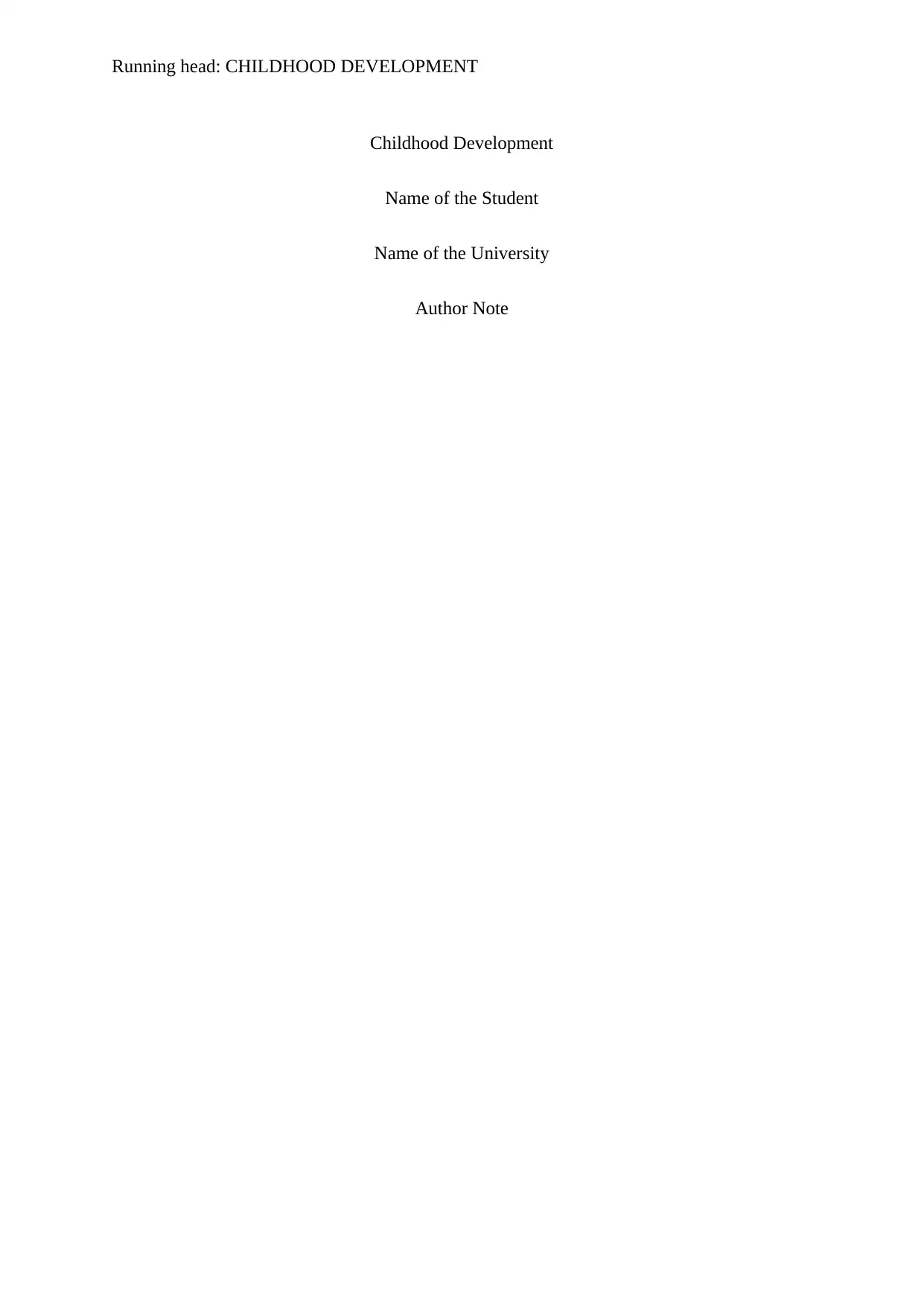
Running head: CHILDHOOD DEVELOPMENT
Childhood Development
Name of the Student
Name of the University
Author Note
Childhood Development
Name of the Student
Name of the University
Author Note
Paraphrase This Document
Need a fresh take? Get an instant paraphrase of this document with our AI Paraphraser
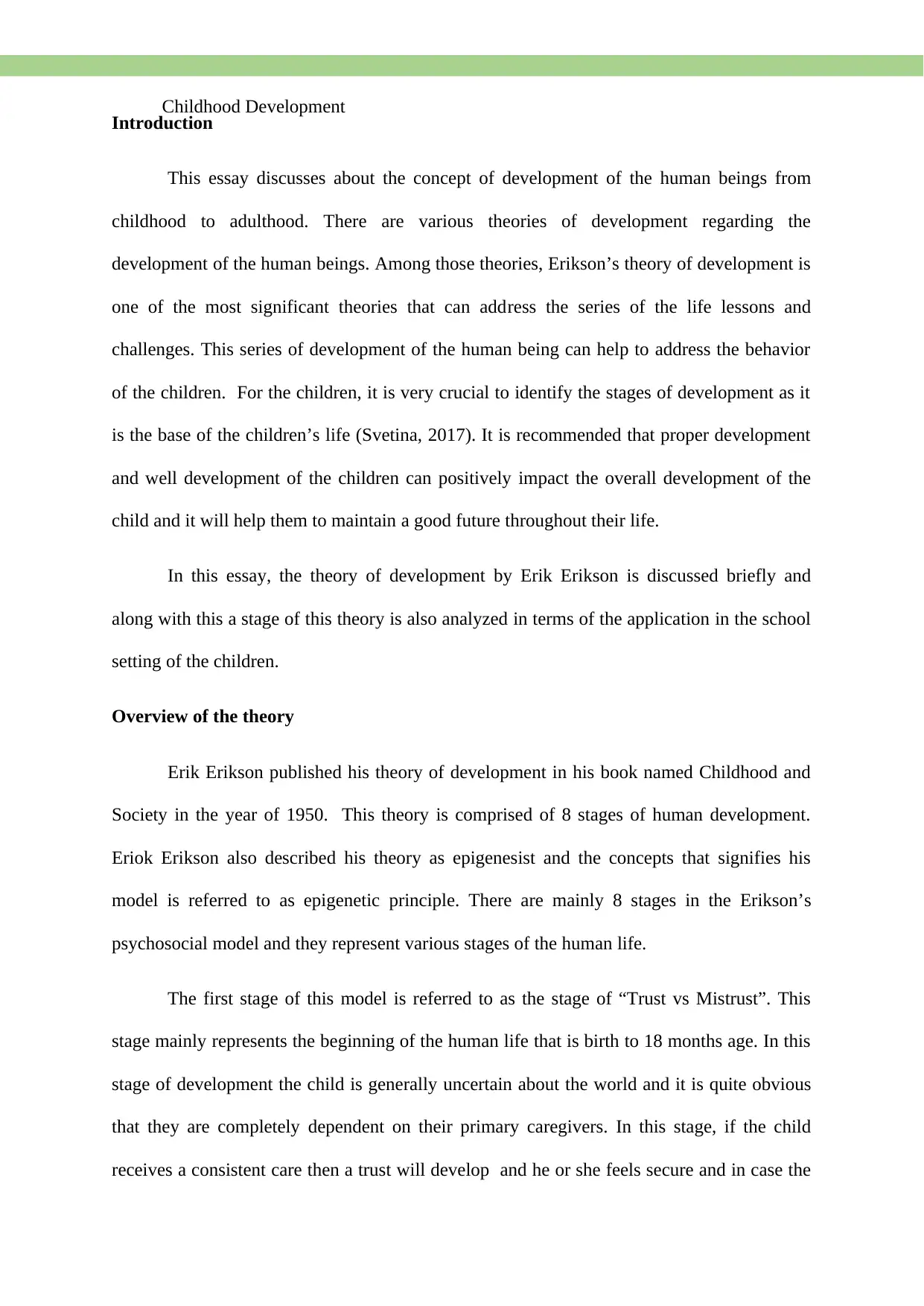
Childhood Development
Introduction
This essay discusses about the concept of development of the human beings from
childhood to adulthood. There are various theories of development regarding the
development of the human beings. Among those theories, Erikson’s theory of development is
one of the most significant theories that can address the series of the life lessons and
challenges. This series of development of the human being can help to address the behavior
of the children. For the children, it is very crucial to identify the stages of development as it
is the base of the children’s life (Svetina, 2017). It is recommended that proper development
and well development of the children can positively impact the overall development of the
child and it will help them to maintain a good future throughout their life.
In this essay, the theory of development by Erik Erikson is discussed briefly and
along with this a stage of this theory is also analyzed in terms of the application in the school
setting of the children.
Overview of the theory
Erik Erikson published his theory of development in his book named Childhood and
Society in the year of 1950. This theory is comprised of 8 stages of human development.
Eriok Erikson also described his theory as epigenesist and the concepts that signifies his
model is referred to as epigenetic principle. There are mainly 8 stages in the Erikson’s
psychosocial model and they represent various stages of the human life.
The first stage of this model is referred to as the stage of “Trust vs Mistrust”. This
stage mainly represents the beginning of the human life that is birth to 18 months age. In this
stage of development the child is generally uncertain about the world and it is quite obvious
that they are completely dependent on their primary caregivers. In this stage, if the child
receives a consistent care then a trust will develop and he or she feels secure and in case the
Introduction
This essay discusses about the concept of development of the human beings from
childhood to adulthood. There are various theories of development regarding the
development of the human beings. Among those theories, Erikson’s theory of development is
one of the most significant theories that can address the series of the life lessons and
challenges. This series of development of the human being can help to address the behavior
of the children. For the children, it is very crucial to identify the stages of development as it
is the base of the children’s life (Svetina, 2017). It is recommended that proper development
and well development of the children can positively impact the overall development of the
child and it will help them to maintain a good future throughout their life.
In this essay, the theory of development by Erik Erikson is discussed briefly and
along with this a stage of this theory is also analyzed in terms of the application in the school
setting of the children.
Overview of the theory
Erik Erikson published his theory of development in his book named Childhood and
Society in the year of 1950. This theory is comprised of 8 stages of human development.
Eriok Erikson also described his theory as epigenesist and the concepts that signifies his
model is referred to as epigenetic principle. There are mainly 8 stages in the Erikson’s
psychosocial model and they represent various stages of the human life.
The first stage of this model is referred to as the stage of “Trust vs Mistrust”. This
stage mainly represents the beginning of the human life that is birth to 18 months age. In this
stage of development the child is generally uncertain about the world and it is quite obvious
that they are completely dependent on their primary caregivers. In this stage, if the child
receives a consistent care then a trust will develop and he or she feels secure and in case the
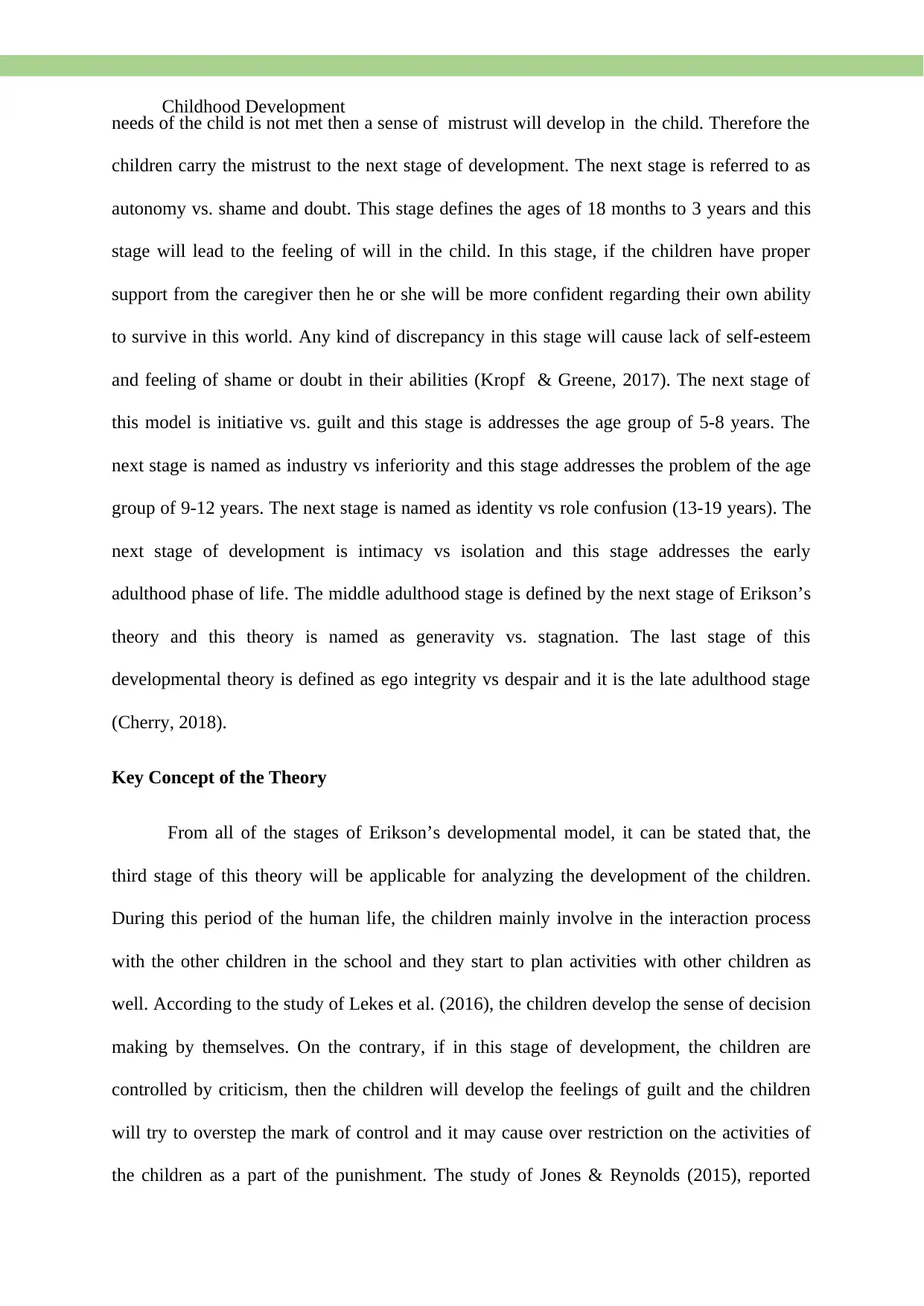
Childhood Development
needs of the child is not met then a sense of mistrust will develop in the child. Therefore the
children carry the mistrust to the next stage of development. The next stage is referred to as
autonomy vs. shame and doubt. This stage defines the ages of 18 months to 3 years and this
stage will lead to the feeling of will in the child. In this stage, if the children have proper
support from the caregiver then he or she will be more confident regarding their own ability
to survive in this world. Any kind of discrepancy in this stage will cause lack of self-esteem
and feeling of shame or doubt in their abilities (Kropf & Greene, 2017). The next stage of
this model is initiative vs. guilt and this stage is addresses the age group of 5-8 years. The
next stage is named as industry vs inferiority and this stage addresses the problem of the age
group of 9-12 years. The next stage is named as identity vs role confusion (13-19 years). The
next stage of development is intimacy vs isolation and this stage addresses the early
adulthood phase of life. The middle adulthood stage is defined by the next stage of Erikson’s
theory and this theory is named as generavity vs. stagnation. The last stage of this
developmental theory is defined as ego integrity vs despair and it is the late adulthood stage
(Cherry, 2018).
Key Concept of the Theory
From all of the stages of Erikson’s developmental model, it can be stated that, the
third stage of this theory will be applicable for analyzing the development of the children.
During this period of the human life, the children mainly involve in the interaction process
with the other children in the school and they start to plan activities with other children as
well. According to the study of Lekes et al. (2016), the children develop the sense of decision
making by themselves. On the contrary, if in this stage of development, the children are
controlled by criticism, then the children will develop the feelings of guilt and the children
will try to overstep the mark of control and it may cause over restriction on the activities of
the children as a part of the punishment. The study of Jones & Reynolds (2015), reported
needs of the child is not met then a sense of mistrust will develop in the child. Therefore the
children carry the mistrust to the next stage of development. The next stage is referred to as
autonomy vs. shame and doubt. This stage defines the ages of 18 months to 3 years and this
stage will lead to the feeling of will in the child. In this stage, if the children have proper
support from the caregiver then he or she will be more confident regarding their own ability
to survive in this world. Any kind of discrepancy in this stage will cause lack of self-esteem
and feeling of shame or doubt in their abilities (Kropf & Greene, 2017). The next stage of
this model is initiative vs. guilt and this stage is addresses the age group of 5-8 years. The
next stage is named as industry vs inferiority and this stage addresses the problem of the age
group of 9-12 years. The next stage is named as identity vs role confusion (13-19 years). The
next stage of development is intimacy vs isolation and this stage addresses the early
adulthood phase of life. The middle adulthood stage is defined by the next stage of Erikson’s
theory and this theory is named as generavity vs. stagnation. The last stage of this
developmental theory is defined as ego integrity vs despair and it is the late adulthood stage
(Cherry, 2018).
Key Concept of the Theory
From all of the stages of Erikson’s developmental model, it can be stated that, the
third stage of this theory will be applicable for analyzing the development of the children.
During this period of the human life, the children mainly involve in the interaction process
with the other children in the school and they start to plan activities with other children as
well. According to the study of Lekes et al. (2016), the children develop the sense of decision
making by themselves. On the contrary, if in this stage of development, the children are
controlled by criticism, then the children will develop the feelings of guilt and the children
will try to overstep the mark of control and it may cause over restriction on the activities of
the children as a part of the punishment. The study of Jones & Reynolds (2015), reported
⊘ This is a preview!⊘
Do you want full access?
Subscribe today to unlock all pages.

Trusted by 1+ million students worldwide
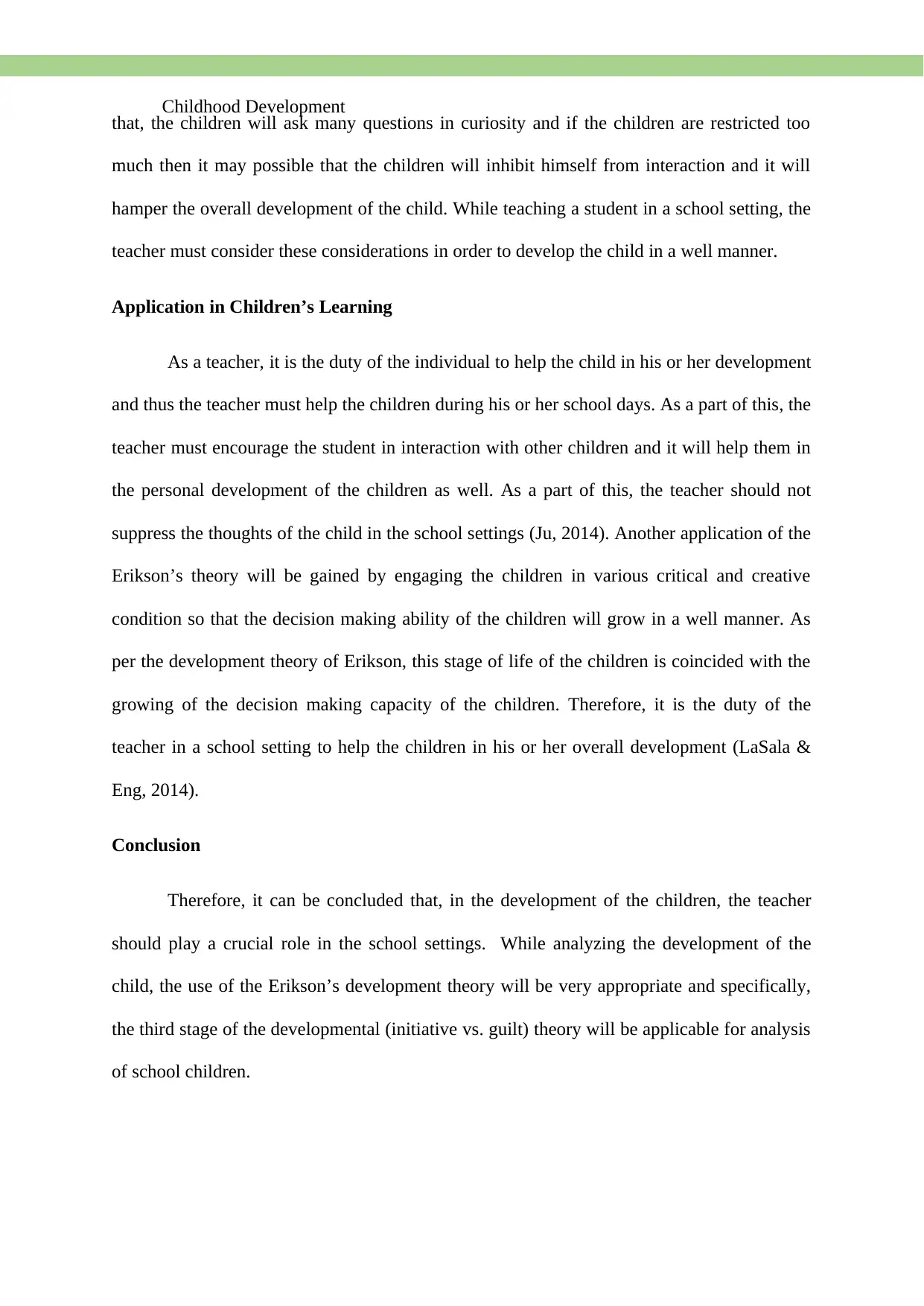
Childhood Development
that, the children will ask many questions in curiosity and if the children are restricted too
much then it may possible that the children will inhibit himself from interaction and it will
hamper the overall development of the child. While teaching a student in a school setting, the
teacher must consider these considerations in order to develop the child in a well manner.
Application in Children’s Learning
As a teacher, it is the duty of the individual to help the child in his or her development
and thus the teacher must help the children during his or her school days. As a part of this, the
teacher must encourage the student in interaction with other children and it will help them in
the personal development of the children as well. As a part of this, the teacher should not
suppress the thoughts of the child in the school settings (Ju, 2014). Another application of the
Erikson’s theory will be gained by engaging the children in various critical and creative
condition so that the decision making ability of the children will grow in a well manner. As
per the development theory of Erikson, this stage of life of the children is coincided with the
growing of the decision making capacity of the children. Therefore, it is the duty of the
teacher in a school setting to help the children in his or her overall development (LaSala &
Eng, 2014).
Conclusion
Therefore, it can be concluded that, in the development of the children, the teacher
should play a crucial role in the school settings. While analyzing the development of the
child, the use of the Erikson’s development theory will be very appropriate and specifically,
the third stage of the developmental (initiative vs. guilt) theory will be applicable for analysis
of school children.
that, the children will ask many questions in curiosity and if the children are restricted too
much then it may possible that the children will inhibit himself from interaction and it will
hamper the overall development of the child. While teaching a student in a school setting, the
teacher must consider these considerations in order to develop the child in a well manner.
Application in Children’s Learning
As a teacher, it is the duty of the individual to help the child in his or her development
and thus the teacher must help the children during his or her school days. As a part of this, the
teacher must encourage the student in interaction with other children and it will help them in
the personal development of the children as well. As a part of this, the teacher should not
suppress the thoughts of the child in the school settings (Ju, 2014). Another application of the
Erikson’s theory will be gained by engaging the children in various critical and creative
condition so that the decision making ability of the children will grow in a well manner. As
per the development theory of Erikson, this stage of life of the children is coincided with the
growing of the decision making capacity of the children. Therefore, it is the duty of the
teacher in a school setting to help the children in his or her overall development (LaSala &
Eng, 2014).
Conclusion
Therefore, it can be concluded that, in the development of the children, the teacher
should play a crucial role in the school settings. While analyzing the development of the
child, the use of the Erikson’s development theory will be very appropriate and specifically,
the third stage of the developmental (initiative vs. guilt) theory will be applicable for analysis
of school children.
Paraphrase This Document
Need a fresh take? Get an instant paraphrase of this document with our AI Paraphraser
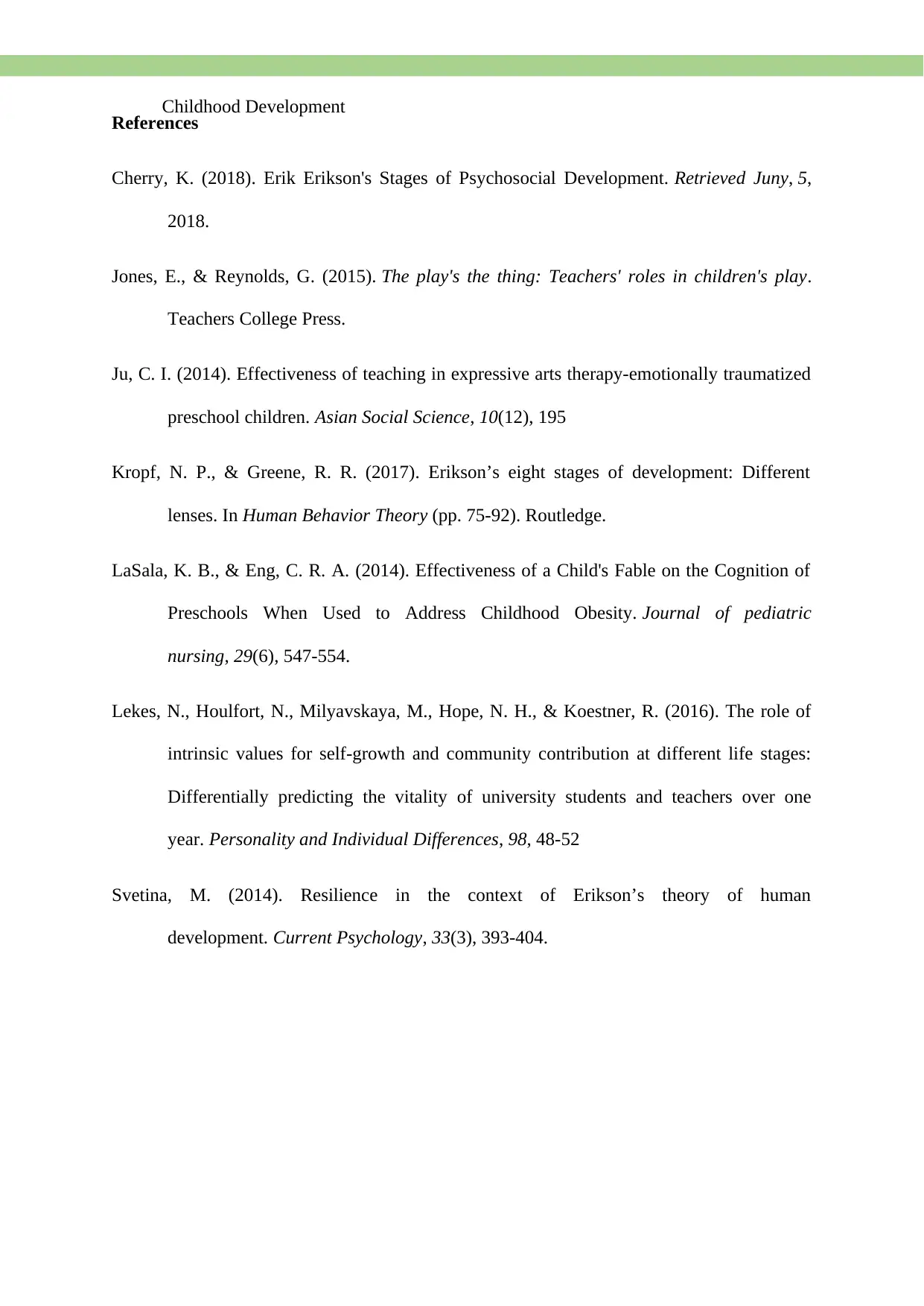
Childhood Development
References
Cherry, K. (2018). Erik Erikson's Stages of Psychosocial Development. Retrieved Juny, 5,
2018.
Jones, E., & Reynolds, G. (2015). The play's the thing: Teachers' roles in children's play.
Teachers College Press.
Ju, C. I. (2014). Effectiveness of teaching in expressive arts therapy-emotionally traumatized
preschool children. Asian Social Science, 10(12), 195
Kropf, N. P., & Greene, R. R. (2017). Erikson’s eight stages of development: Different
lenses. In Human Behavior Theory (pp. 75-92). Routledge.
LaSala, K. B., & Eng, C. R. A. (2014). Effectiveness of a Child's Fable on the Cognition of
Preschools When Used to Address Childhood Obesity. Journal of pediatric
nursing, 29(6), 547-554.
Lekes, N., Houlfort, N., Milyavskaya, M., Hope, N. H., & Koestner, R. (2016). The role of
intrinsic values for self-growth and community contribution at different life stages:
Differentially predicting the vitality of university students and teachers over one
year. Personality and Individual Differences, 98, 48-52
Svetina, M. (2014). Resilience in the context of Erikson’s theory of human
development. Current Psychology, 33(3), 393-404.
References
Cherry, K. (2018). Erik Erikson's Stages of Psychosocial Development. Retrieved Juny, 5,
2018.
Jones, E., & Reynolds, G. (2015). The play's the thing: Teachers' roles in children's play.
Teachers College Press.
Ju, C. I. (2014). Effectiveness of teaching in expressive arts therapy-emotionally traumatized
preschool children. Asian Social Science, 10(12), 195
Kropf, N. P., & Greene, R. R. (2017). Erikson’s eight stages of development: Different
lenses. In Human Behavior Theory (pp. 75-92). Routledge.
LaSala, K. B., & Eng, C. R. A. (2014). Effectiveness of a Child's Fable on the Cognition of
Preschools When Used to Address Childhood Obesity. Journal of pediatric
nursing, 29(6), 547-554.
Lekes, N., Houlfort, N., Milyavskaya, M., Hope, N. H., & Koestner, R. (2016). The role of
intrinsic values for self-growth and community contribution at different life stages:
Differentially predicting the vitality of university students and teachers over one
year. Personality and Individual Differences, 98, 48-52
Svetina, M. (2014). Resilience in the context of Erikson’s theory of human
development. Current Psychology, 33(3), 393-404.
1 out of 5
Related Documents
Your All-in-One AI-Powered Toolkit for Academic Success.
+13062052269
info@desklib.com
Available 24*7 on WhatsApp / Email
![[object Object]](/_next/static/media/star-bottom.7253800d.svg)
Unlock your academic potential
Copyright © 2020–2025 A2Z Services. All Rights Reserved. Developed and managed by ZUCOL.





